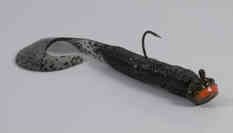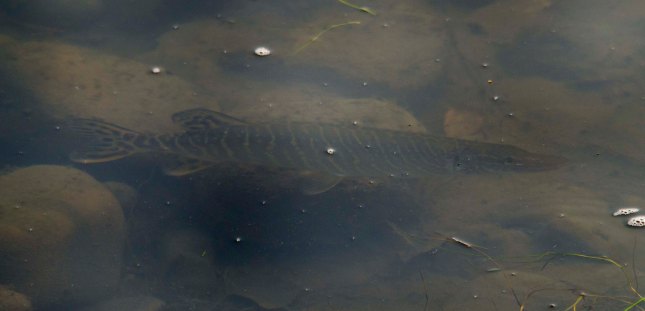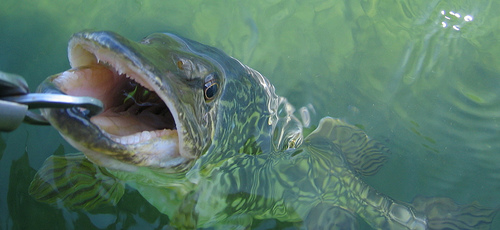 Jigs catch just about anything that swims, but excel with certain fish – northern pike being one of them. Jigs are an excellent bait to work along the bottom when pike are shallow in spring. Here’s where to find spring pike and how to fool them with jigs at the start of the season.
Jigs catch just about anything that swims, but excel with certain fish – northern pike being one of them. Jigs are an excellent bait to work along the bottom when pike are shallow in spring. Here’s where to find spring pike and how to fool them with jigs at the start of the season.
Spawning Moves
Northern pike are considered a cool-water fish. Their mating ritual takes place immediately following ice out sometime between April and early May depending on latitude; the optimal temperature range for spawning is between 40- to 52 degrees Fahrenheit. Spring flooding and high-water levels contribute to pike spawning habitat. Typical zones include marshes, swollen creeks, back bays, sheltered shorelines, and flooded land. Pike prefer soft bottoms for spawning, such as sand or silt, mixed with new, emerging vegetation or plant debris, such as bulrushes.
 A basic jig and grub combination works well for shallow-water pike.
A basic jig and grub combination works well for shallow-water pike.
Knowing the location and timing of northern pike spawning will help you catch them come season opener. Fish will linger in the shallows in close proximity to these mating locales for a few weeks. They bask in the sun and are drawn to shallow, warming waters. Here, pike replenish their strength after the rigors of spawning while also taking advantage of various food items found in the “skinny” water.
Bays And Flats
The first few weeks of pike season, I concentrate my casting efforts on shallow-water regions. Protected bays off of rivers and lakes are one of my top spots. The best bays will be near spawning areas. Bays in front of a marsh or a feeder creek are classic early-season producers. Pike will recuperate in the bay after spawning in the flooded shallows. Northern may also hold on sand areas near shore or the bay’s entrance points. If the bay has a deep hole, pike will often station in it during foul, cold weather and at night. Shallow flats, between 6- and 12 feet deep will also hold northern. Again, these areas are best when close to spawning grounds.
Jig Options
 Small jigs work well this time of year. Pike don’t discriminate against little baits. I regularly catch northern when targeting other species, such as walleyes, using jigs. Spring is the time of year when 3- to 4-inch grubs, shads, and soft-plastic jerk baits on a 1/4-ounce jigs catch plenty of spring-time pike. Buck tail jigs with the same characteristics are just as deadly.
Small jigs work well this time of year. Pike don’t discriminate against little baits. I regularly catch northern when targeting other species, such as walleyes, using jigs. Spring is the time of year when 3- to 4-inch grubs, shads, and soft-plastic jerk baits on a 1/4-ounce jigs catch plenty of spring-time pike. Buck tail jigs with the same characteristics are just as deadly.
Be sure smaller-sized jigs have a strong hook. Thin wire hooks could bend under too much pressure when battling large pike. Also, a drop of high-strength glue applied to the jig collar before completely treading on the body holds plastics in place, preventing them from sliding down the hook shank.
Drag ‘Em
When pike are sluggish during early, cool mornings a drag-pause retrieve along soft-bottom areas works well. Sand and mud don’t hold many snags so maintaining bottom contact isn’t an issue. Dragging the bait also kicks up a silt trail, which often attracts pike. Pike eat anything appearing vulnerable. They feed on frogs burrowed in the mud, so dragging baits along soft bottom bays, flats, and shorelines is an excellent spring tactic.
Sight Fishing Tips
 In spring, you can sight-fish pike in calm conditions. Toss jigs past the fish. Then work it into the strike zone. Hoping the jig might trigger a reaction strike, while in other situations pauses and jiggles are better for sluggish fish.
In spring, you can sight-fish pike in calm conditions. Toss jigs past the fish. Then work it into the strike zone. Hoping the jig might trigger a reaction strike, while in other situations pauses and jiggles are better for sluggish fish.
Always look for structure and cover. Sunken logs, small dips in the bottom, weed edges, and boulders all offer ambushing advantages. Cast jigs to these zones even if you don’t see pike near them. Last year during an early season outing in ripple-water conditions a friend of mine tossed his bait to what he thought was a log. Well the log had teeth and an appetite! It ended up being a decent pike worthy of a few photos.
Deeper Water Holds Fish, Too
 Don’t neglect slightly deeper water near spawning sites. Good zones are entrances to weedy bays and their bordering points. I concentrate on areas up to about 15 feet deep around spawning sites. Cast jigs into the shallows and work them along bottom. Also count-down jigs, and then swim or hop them through the water column for cruising, active fish.
Don’t neglect slightly deeper water near spawning sites. Good zones are entrances to weedy bays and their bordering points. I concentrate on areas up to about 15 feet deep around spawning sites. Cast jigs into the shallows and work them along bottom. Also count-down jigs, and then swim or hop them through the water column for cruising, active fish.
Best Spring Jig Fishing Outfits
To cast light jigs at the start of the season, use either a medium-heavy spinning or bait cast rod as you’re rarely fishing near heavy weeds or wood cover. Going with a ultra-fast or fast-action rod ensures you can toss these jigs a considerable distance while maintaining accuracy for sight fishing scenarios. Be sure though the blank has plenty of backbone to muscle big pike. On my spring outfits, I use 30 to 40 pound test teamed with 9 to 12 inch, multi-strand wire leaders. Fluorocarbon leaders in the 60-pound range are also effective in clear-water scenarios, but check regularly for nicks that will weaken the leader material.
Hooking Followers
Pike often follow baits. The best scenario is spotting a fish a distance from the boat. If it looks aggressive, try speeding up the retrieve or adding some snaps. This imitates escape moves and sometimes triggers bites. If the fish appears lazy, slow the retrieve slightly. If working the bait along bottom, leave it still and work in short drags and pauses. If you spot a following pike close to the boat while your jig is traveling upwards, letting out line so the jig falls is your best option.
The Throw-Back Bait
If you’re not sure where the fish went, fan cast the area using a yo-yo swimming retrieve or work the bait along bottom. Pike that followed, but were uninterested in striking a fast-moving, horizontal presentations can often be fooled into biting a jig.
Spring is an exciting time to angle for pike. So try some different jig options this season to score plenty of fish at the start of the season.
Good luck on your next northern pike fishing trip!
Follow our HUNTING BLOG
WEB RATES FISH HUNT CABINS PHOTOS
TESTIMONIALS BROCHURE HUNT BOOKLET
